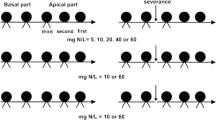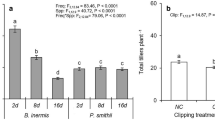Abstract
Invasive species are one of the main causes for the loss of global biodiversity. However, the mechanisms that explain the success of invasive species remain unsolved. Clonal growth has been pointed out as an attribute that could contribute to the invasiveness of plants, however little research has been conducted to determine the importance of clonal traits in successful invaders. One of the most interesting attributes related to clonal growth is the capacity for division of labour. In this experiment we investigated the capacity for division of labour in the aggressive invader Carpobrotus edulis, and how clonal integration can contribute to the expansion of this species. Division of labour was determined by studying the degree of morphological and physiological specialization of individual ramets to a specific activity: acquisition of soil or aboveground resources and aboveground expansion. Our results showed that there is division of labour in the clonal fragments, with older ramets increasing the biomass allocated to roots (specialization in the uptake of belowground resources) and younger ramets increasing the chlorophyll content and aboveground biomass (specialization in the uptake of aboveground resources). Physiological integration allows division of labour, and as consequence the overall performance of the clonal fragment was enhanced, with connected clonal fragments showing a higher total biomass than severed clonal fragments. Division of labour increased the aboveground growth of apical ramets of C. edulis, and therefore could contribute to an effective colonization of the surrounding area by this aggressive invader. Our study is the first exploring the role of division of labour in the expansion of an invader, and supports the idea that clonal traits could increase the invasiveness of plant species.





Similar content being viewed by others
References
Aguilera AG, Alpert P, Dukes JS, Harrington R (2010) Impacts of the invasive plant Fallopia japonica (Houtt.) on plant communities and ecosystem processes. Biol Invasions 12:1243–1252
Alpert P (1996) Nutrient sharing among ramets increases clonal growth in Fragaria chiloensis. J Ecol 84:395–406
Alpert P (1999) Clonal integration in Fragaria chiloensis differs between populations: ramets from grassland are selfish. Oecologia 120:69–76
Alpert P, Mooney HA (1986) Resource sharing among ramets in the clonal herb, Fragaria chiloensis. Oecologia 70:227–233
Alpert P, Stuefer JF (1997) Division of labour in clonal plants. In: de Kroon H, van Groenendael J (eds) The ecology and evolution of clonal plants. Backhuys Publishers, Leiden, pp 137–154
Alpert P, Bone E, Holzapfel C (2000) Invasiveness, invasibility, and the role of environmental stress in preventing the spread of non-native plants. Perspect Plant Ecol Evol Syst 3:52–66
Amsberry L, Baker MA, Ewanchuk PJ, Bertness MD (2000) Clonal integration and the expansion of Phragmites australis. Ecol Appl 10:1110–1118
Birch CPD, Hutchings MJ (1994) Exploitation of patchily distributed soil resources by the clonal herb Glechoma hederacea. J Ecol 82:653–664
Blackburn TM, Pyšek P, Bacher S, Carlton JT, Duncan RP, Jaroší V, Wilson JRU, Richardson DM (2011) A proposed unified framework for biological invasions. Trends Ecol Evol 26:333–339
Bolhàr-Nordenkampf HR, Long SP, Baker NR, Öquist G, Scheiber U, Lechner EG (1989) Chlorophyll fluorescence as a probe of the photosynthetic competence of leaves in the field: a review of current instrumentation. Funct Ecol 3:497–514
Butler W, Kitajima M (1975) Fluorescence quenching in photosystem II of chloroplasts. Biochim Biophys Acta 376:116–125
Costa JC, Lousã M, Capelo J, Espírito Santo MD, Izco Sevillano J, Arsénio P (2000) The coastal vegetation of the Portuguese divisory sector: dunes cliffs and low-scrub communities. Finisterra XXXV 69:69–93
D’Antonio CM (1993) Mechanisms controlling invasion of coastal plant communities by the alien succulent Carpobrotus edulis. Ecology 74:83–95
D’Antonio CM, Mahall BE (1991) Root profiles and competition between the invasive, exotic perennial, Carpobrotus edulis, and two native shrub species in California coastal scrub. Am J Bot 78:885–894
de Kroon H, Fransen B, van Rheenen JWA, van Dijk A, Kreulen R (1996) High levels of inter-ramet water translocation in two rhizomatous Carex species, as quantified by deuterium labelling. Oecologia 106:73–84
Dyham C (1999) Choosing and using statistics: A biologist’s guide. Blackwell Science, London, pp 131–136
Friedman D, Alpert P (1991) Reciprocal transport between ramets increases growth of Fragaria chiloensis when light and nitrogen occur in separate patches but only if patches are rich. Oecologia 86:76–80
Gamon JA, Serrano I, Surfus JS (1997) The photochemical reflectance index: an optical indicator of photosynthetic radiation use efficiency across species, functional types, and nutrient levels. Oecologia 112:492–501
Genty BE, Briantais JM, Baker NR (1989) The relationship between the quantum yield of photosynthetic electron transport and quenching of chlorophyll fluorescence. Biochim Biophys Acta 990:87–92
Guo J, Trotter CM (2004) Estimating photosynthetic light-use efficiency using the photochemical reflectance index: variations among species. Funct Plant Biol 31:255–265
Hartnett DC, Bazzaz FA (1983) Physiological integration among intraclonal ramets in Solidago canadensis. Ecology 64:779–788
Hutchings MJ, Wijesinghe DK (1997) Patchy habitats, division of labour and growth dividends in clonal plants. Trends Ecol Evol 12:390–394
Kliměs L, Kliměsova J, Hendriks R, van Groenendael J (1997) Clonal plant architecture: a comparative analysis of form and function. In: de Kroon H, van Groenendael J (eds) The ecology and evolution of clonal plants. Backhuys Publishers, Leiden, pp 1–29
Latzel V, Klimešová J (2009) Fitness of reprouters versus seeders in relation to nutrient availability in two Plantago species. Acta Oecol 35:541–547
Levine JM, Vilà M, D’Antonio CM, Dukes JS, Grigulis K, Lavorel S (2003) Mechanisms underlying the impacts of exotic plant invasions. Proc R Soc B 270:775–781
Lichtenthaler HK, Gitelson A, Lang M (1996) Non-destructive determination of chlorophyll content of leaves of a green and an Aurea mutant of tobacco by reflectance measurements. J Plant Physiol 148:483–493
Liu J, Dong M, Miao S, Li Z, Song M, Wang R (2006) Invasive alien plants in China: role of clonality and geographical origin. Biol Invasions 8:1461–1470
Liu J, He WM, Zhang SM, Liu FH, Dong M, Wang RQ (2008) Effect of clonal integration on photosynthesis of the invasive clonal plant Alternanthera philoxeroides. Photosynthetica 46:299–302
Mack RN, Simberloff D, Lonsdale WM, Evans H, Clout M, Bazzaz FA (2000) Biotic invasions: causes, epidemiology, global consequences, and control. Ecol Appl 10:689–710
Maxwell K, Johnson GN (2000) Chlorophyll fluorescence—a practical guide. J Exp Bot 51:659–668
Oborny B, Bartha S (1995) Clonality in plant communities—an overview. Abstr Bot 19:115–127
Otfinowski R, Kenkel NC (2008) Clonal integration facilitates the proliferation of smooth brome clones invading northern fescue prairies. Plant Ecol 199:235–242
Peltzer DA (2002) Does clonal integration improve competitive ability? A test using aspen (Populus tremuloides [Salicaceae]) invasion into prairie. Am J Bot 89:494–499
Pennings SC, Callaway RM (2000) The advantages of clonal integration under different ecological conditions: a community-wide test. Ecology 81:709–716
Peñuelas J, Filella I, Gamon JA (1995) Assessment of photosynthetic radiation-use efficiency with spectral reflectance. New Phytol 131:291–296
Pitelka LF, Ashmun JW (1985) Physiology and integration of ramets in clonal plants. In: Jackson JBC, Buss LW, Cook RE (eds) Population biology and evolution of clonal organisms. Yale University Press, New Haven, pp 339–437
Price EAC, Hutchings MJ (1992) The causes and developmental effects of integration and independence between different parts of Glechoma hederacea clones. Oikos 63:376–386
Price EAC, Marshall C (1999) Clonal plants and environmental heterogeneity. Plant Ecol 141:3–7
Pyšek P (1997) Clonality and plant invasion: can a trait make a difference? In: de Kroon H, van Groenendal J (eds) The ecology and evolution of clonal plants. Backhuys Publishers, Leiden, pp 405–427
Rejmánek M, Richardson DM (1996) What attributes make some plant species more invasive? Ecology 77:1655–1661
Roiloa SR, Hutchings MJ (2012) The effects of rooting frequency and position of rooted ramets on plasticity and yield in a clonal specie: an experimental study with Glechoma hederacea. Ecol Res 27:145–152
Roiloa SR, Retuerto R (2005) Presence of developing ramets of Fragaria vesca increase photochemical efficiency in parent ramets. Int J Plant Sci 166:795–803
Roiloa SR, Retuerto R (2006) Physiological integration ameliorates effects of serpentine soils in the clonal herb Fragaria vesca. Physiol Plantarum 128:662–676
Roiloa SR, Alpert P, Nishanth T, Hancock G, Bhowmik P (2007) Greater capacity for division of labour in clones of Fragaria chiloensis from patchier habitats. J Ecol 95:397–405
Roiloa SR, Rodríguez-Echeverría S, de la Peña E, Freitas H (2010) Physiological integration increases survival and growth of the clonal invader Capobrotus edulis. Biol Invasions 12:1815–1823
Saitoh T, Seiwa K, Nishiwaki A (2002) Importance of physiological integration of dwarf bamboo to persistence in forest understorey: a field experiment. J Ecol 90:78–85
Schmid B (1990) Some ecological and evolutionary consequences of modular organization and clonal growth in plants. Evol Trend Plant 4:25–34
Schreiber U, Bilger W, Hormann H, Neubauer C (1998) Chlorophyll fluorescence as a diagnostic tool: basics and some aspects of practical relevance. In: Raghavendra AS (ed) Photosynthesis. A Comprehensive Treatise. Cambridge University Press, Cambridge, pp 320–336
Sims DA, Gamon JA (2002) Relationships between leaf pigment content and spectral reflectance across a wide range of species, leaf structures and developmental stages. Remote Sens Environ 81:337–354
Slade AJ, Hutchings MJ (1987) An analysis of the costs and benefits of physiological integration between ramets in the clonal perennial herb Glechoma hederacea. Oecologia 73:425–431
Stuefer J (1998) Two types of division of labour in clonal plants: benefits, costs and constraints. Perspect Plant Ecol Evol Syst 1:47–60
Stuefer JF, Huber H (1999) The role of stolon internodes for ramet survival after clone fragmentation in Potentilla anserina. Ecol Lett 2:135–139
Stuefer JF, de Kroon H, During HJ (1996) Exploitation of environmental heterogeneity by spatial division of labour in a clonal plant. Funct Ecol 10:328–334
Stylinski CD, Gamon JA, Oechel WC (2002) Seasonal patterns of reflectance indices, carotenoid pigments and photosynthesis of evergreen chaparral species. Oecologia 131:366–374
Traveset A, Moragues E, Valladares F (2008) Spreading of the invasive Carpobrotus aff. acinaciformis in Mediterranean ecosystems: the advantage of performing in different light environments. Appl Veg Sci 11:45–54
Vilà M, Siamantziouras AKD, Brundu G, Camarda I, Lambdon P, Médail F, Moragues E, Suehs CM, Traveset A, Troumbis AY, Hulme PE (2008) Widespread resistance of Mediterranean island ecosystems to the establishment of three alien species. Divers Distrib 14:839–851
Vitousek PM, D’Antonio CM, Loope LL, Westbrooks R (1996) Biological invasions as global environmental change. Am Sci 84:468–478
Wang N, Yu FH, Li PX, He WM, Liu FH, Liu JM, Dong M (2008) Clonal integration affects growth, photosynthetic efficiency and biomass allocation, but not the competitive ability, of the alien invasive Alternanthera philoxeroides under severe stress. Ann Bot 101:671–678
Wang Z, Li Y, During HJ, Li L (2011) Do clonal plants show greater division of labour morphologically and physiologically at higher patch contrasts? PLoS One 6(9):e25401. doi:101371/journal.pone.0025401
Wisura W, Glen HF (1993) The South African species of Carpobrotus (Mesembryanthema–Aizoaceae). Contrib Bolus Herb 15:76–107
Wood CW, Reeves DW, Himelrick DG (1993) Relationships between chlorophyll meter readings and leaf chlorophyll concentration, N status, and crop yield: a review. Proc Agron Soc N Z 23:1–9
Zhang YC, Zhang QY, Luo P, Wu N (2009) Photosynthetic response of Fragaria orientalis in different water contrast clonal integration. Ecol Res 24:617–625
Acknowledgments
S. R. R. was financed by a grant of the Portuguese Foundation for Science and Technology (FCT) (Reference: SFRH/BPD/79599/2011) co-funded by the European Social Fund of the European Union. We are grateful to three anonymous referees for their valuable comments on a previous version of this paper.
Author information
Authors and Affiliations
Corresponding author
Rights and permissions
About this article
Cite this article
Roiloa, S.R., Rodríguez-Echeverría, S., Freitas, H. et al. Developmentally-programmed division of labour in the clonal invader Carpobrotus edulis . Biol Invasions 15, 1895–1905 (2013). https://doi.org/10.1007/s10530-013-0417-z
Received:
Accepted:
Published:
Issue Date:
DOI: https://doi.org/10.1007/s10530-013-0417-z




